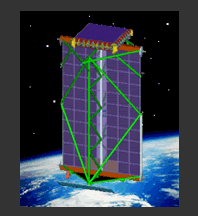| The
HNX Mission
The HNX instruments are necessarily large and heavy. One of the instruments. ECCO, collects physical data that must be recovered to be analyzed in the laboratory. Thus, HNX requires the unique launch and retrieval capabilities of the Space
Shuttle. It is an ideal Space-Shuttle-enabled science mission.
HNX is a simple mission. Ninety two percent of the HNX mass is structure or systems requiring no power or
telemetry. The ECCO instrument, which is half of the total mass of HNX, is completely passive. The
incident cosmic rays are isotropic. without any particular celestial orientation, so the instruments require only coarse pointing (5 degrees in pitch and roll) relative to zenith. The spacecraft can meet these pointing requirements using only magnetic actuators.
The HNX mission is planned for launch in October 2005 into a 475-km circular orbit at an inclination of 51.6°. Recovery is planned nominally for 3 years following launch. We have included funding for a 6-month launch delay in our cost proposal to mitigate uncertainties in the Shuttle manifest that could result in unanticipated delays.
The minimum success criteria for both ECCO and ENTICE require 18 months in orbit; the goal is three years of data collection on-orbit.
HNX is resilient to both launch and recovery delays. The HNX science is not sensitive to launch delays; even with a delay of two years, the mission will still bracket the period of solar minimum (maximum cosmic-ray flux). Delay in recovery is not critical either, as longer exposure time improves statistics. However. since the ECCO data analysis cannot begin until instrument recovery, we have concluded that three years provides both adequate numbers of particles collected and a reasonable analysis delay for ECCO.
The HNX design employs robust technical margins. The design has greater than 30% margins on mass, power, attitude control, data rate, and processor utilization.
The Mission Operations Center (MOC) for HNX will be located at U.C Berkeley and will use the already existing FAST and HESSI MOC The Berkeley Ground Station will be used for S/C commanding and telemetry
reception.
The
HNX Heritage
<Top>
The HNX instruments and S/C implement existing, well-developed designs with extensive flight heritage. HNX incorporates these systems utilizing personnel with direct and relevant experience from the previous missions. This results in well-understood science capabilities and in
well defined cost and schedule.
ECCO is based on the heritage of Trek, a 1.2m² array of BP-1 track-etch detectors deployed on Mir from 1991-1995. Using Trek, we measured the abundances of elements in the lead-platinum group in the galactic cosmic rays. ECCO uses the same detector as Trek, but in a different configuration.
The ENTICE experiment is a follow-on to the HEAO-3 C3 experiment flown in 1979 and was studied as a potential addition to ACCESS. The ACE CRIS and SIS experiments provide significant heritage for the ENTICE silicon and scintillating fiber detectors. We are planning to use the ACE-VLSI circuitry to read out all of the sensors on ENTICE. Similarly, the TIGER balloon payload provides heritage for the ENTICE Cherenkov detectors and scintillating fiber hodoscope. (TIGER is a one square meter instrument
similar to ENTICE that has flown successfully on a high altitude balloon and is currently standing by for a 12/2001 Long Duration Balloon flight in Antarctica.)
The avionics system of the HNX S/C is a direct implementation of SMEX-Lite, as used on the environmentally-qualified Triana S/C. The HNX S/C team is composed of personnel from the EO-1, Triana, and FUSE missions.
The
HNX Management Plan
<Top>
The HNX Project will contain costs well within the limits established by the NASA/GSFC Explorer Program Office. We have integrated all participating institutions into a tightly knit team, led by the HNX PI Dr. Binns, which will meet the challenges of the HNX Project. Our organizational structure (Figure ES-4) establishes clear management accountability for products. Team members and institutions have extensive experience in delivering similar systems for other projects within budget and schedule. Our team members are WU (PI institution, ENTICE management, ENTICE hodoscope, central processing electronics. electrical GSE, and the ENTICE science data center), GSFC (Project Management, Mission Systems Engineering, ENTICE Cherenkov counters, and mechanical design), UCB (ECCO instrument and analysis, mission operations center, ground station,
EPO), Swales (spacecraft development, instrument thermal design, and mission integration and test), CIT/JPL (ENTICE silicon detectors, aerogel Cherenkov radiator. and front-end electronics design and VLSI). MSFC (ENTICE power system and mechanical GSE), Michigan (ECCO instrument and analysis). Minnesota (ECCO and ENTICE science theory), and Japanese colleagues (ECCO analysis and ENTICE silicon).
Our principal programmatic risks relate to the uncertainties in the manifesting of the HNX payload on the Space Shuttle. These risks, and our work to mitigate them, are addressed in later sections of this report. Significant cost, schedule and technical reserves are baselined to mitigate risks.
<Top>

Figure ES-4. HNX Organization Chart
|



